How to Choose a Hydroponic Grow Sponge + Which Ones You Should Avoid…

This post follows our research editorial guidelines.

System, seed, solution and substrate – these are four special ingredients to a successful home hydroponics system. Many commercial hydroponics systems like the AeroGarden take the hassle out of choosing all of the above, but in time you’ll need to replace the sponges that come with your kid. How do you choose the best sponge for your hydroponics setup? What are your options? And can you cut out the middleman and make your own?
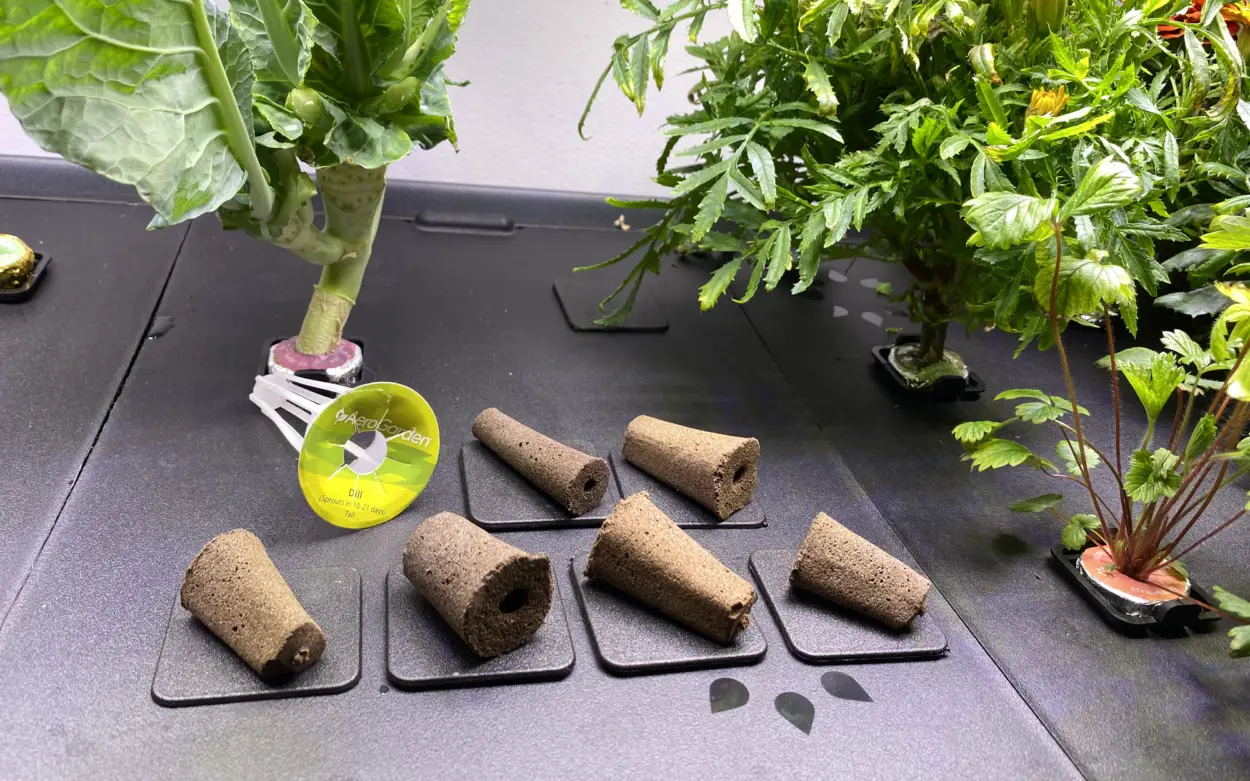
Table of Contents
What is a Grow Sponge?
A grow sponge is a small piece of spongy material designed to hold your plant securely in your hydroponic garden. Seeds are placed in the top of the sponge, and the roots grow through the material and out into your hydroponic solution. It is elegant in its simplicity.
Sponges work for this practice because they absorb nutrient solution while also holding air pockets to provide roots with oxygen. As your seedlings grow, they provide physical support by gently holding the plant in its basket while the roots swim freely in the solution below.
What are the Different Types of Sponges Available?
Peat Moss or Coco Coir Sponges
These sponges are sometimes called ‘rooting plugs’ and are tightly packed masses of peat moss, coco coir or similar organic material. They behave much like a sponge in that they suck up moisture and hold nutrient solution close to the roots. Peat and coir also contain a fair bit of nutrition to start with, and are particularly useful for germinating seeds. They’re also biodegradable and can be composted once your crop is harvested.
On the downside, there’s a lot of variation depending on the brand and the material. They are prone to water-logging, they lose shape fast, and they tend to break down quite quickly. Peat moss or coco coir grow sponges are my go-to option for hydroponic growing since their easy to use and have a slightly acidic to neutral pH that bodes well for seedlings to start germinating.
Cellulose Sponges
These are sponges made from processed cellulose fibre, a naturally occurring substance that can be found in plant tissue of all types. Generally, the cellulose used to make sponges comes from wood pulp, but trendy bamboo kitchen sponges are also made from cellulose taken from bamboo.
Cellulose sponge has a lot going for it. It’s cheap and readily available, both as pre-formed plugs and as sheets. Cellulose kitchen sponge is just as good for hydro as purpose-made blocks, so if you’ve got a small setup it’s a thrifty choice. Once you’re done with it the sponge can be discarded, safe in the knowledge that as a natural fibre the cellulose will decompose in time.
The chief drawback of cellulose sponge is, ironically, its biodegradability. It’ll break down in your system slowly but surely. But with a bit of practice, it’s an economical and environmentally friendly choice.
Polyurethane Sponges
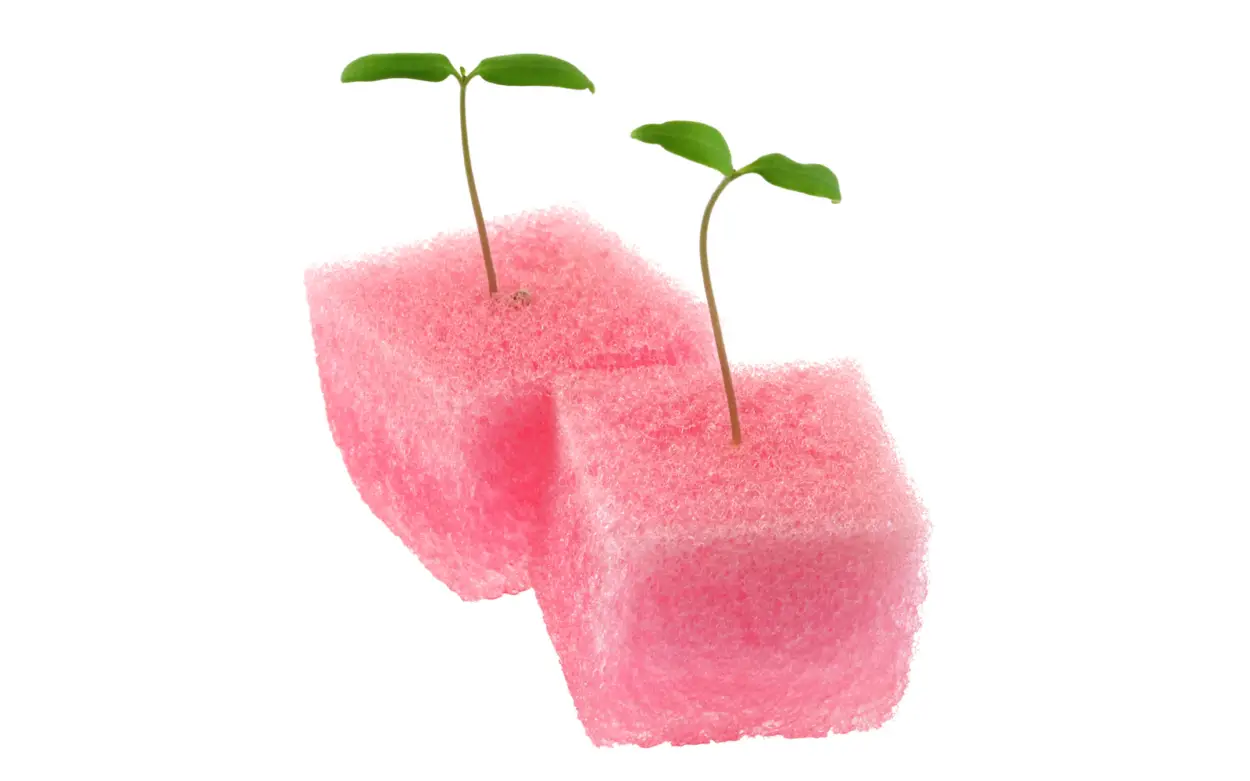
Polyurethane sponges are made from plastic, plain and simple. It’s cheap and cheerful, stable from the second it’s made, and it won’t take much practice for home growers to get used to the stuff.
It’s not as absorbent as cellulose but it does tend to hold air better. Depending on the grade you may find it very dense and a bit trickier to work with. Finally, this is not a biodegradable option, so be aware that every bit of PU sponge you use will be sitting in landfall for eons after use.
How to Choose the Right Grow Sponge for your Hydroponic Garden
When choosing what type of sponge is best for you, you’ll need to ensure the essential needs of your crop are met. For a growing medium, that means how well it provides water and nutrients to the roots. You’ll need to look at the properties of the sponge and see how they deliver.
“Hydroponic systems must deliver the essential components of plant life normally found in the garden. These are light, air, nutrients, and water. All methods of hydroponics have the advantage of efficiently delivering water and nutrients to plants.”
Glen Bupp, Extension Educator, University of Pennsylvania Horticulture Department.
The Texture of the Grow Sponge
While there’s a few unifying features of each sponge material, the biggest difference is the texture of the sponge itself.
A heavy, dense sponge has many small pores inside it. These are great for absorbency and oxygen retention but can be tough for some plants to penetrate with their roots. They also drain slowly, so are better for thirsty crops.
On the other hand and open, airy structure with lots of big air pockets will drain faster and hold less of your nutrient solution. They’re very easy for roots to wriggle through, but they dry out faster.
The Size of Your Nets
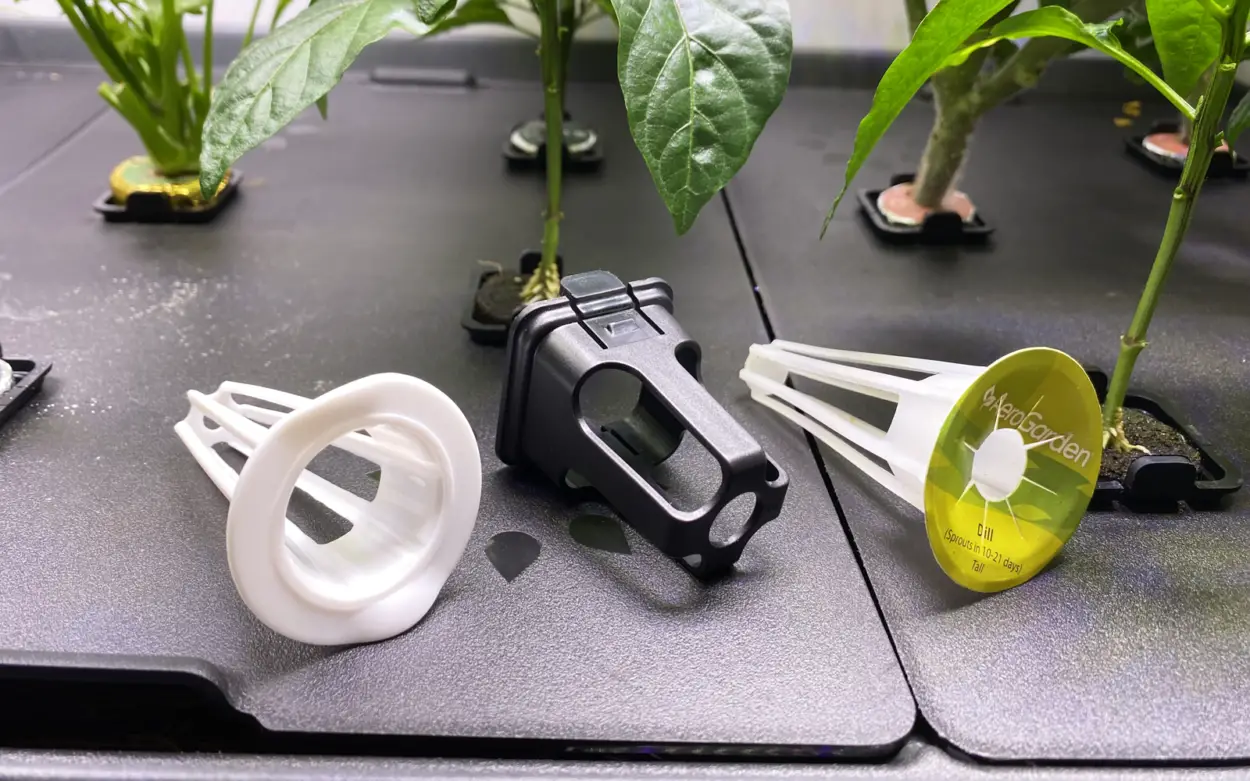
Size is important too. Pre-cut sponges that just don’t fit your rig are a waste of time and money. Take a measurement of your net (preferably in millimetres) both in terms of the net’s circumference and length. That’ll help you get a good fit when buying your sponge.
The Type of Kit You are Using
The absolute easiest way to pick your sponge when using a commercial hydroponics kit is to simply buy the manufacturer’s replacement set. AeroGarden, Rise Garden, and Gardyn all provide replacement kits.
But if you do want to take control of your home hydroponics setup, you can reverse engineer your own replacements when the time comes. Hold onto components like grow nets and caps, and take a look at how the original medium was shaped and positioned. You may find that it’s pretty straightforward making your own replacement sponges from commercially available hydroponic sponge or even kitchen sponges.
DIY users have it easier still. If you’ve made your own hydro rig you already have a good grip on the size of your system and how the solution is delivered to your plants.
The Type of Plant You are Growing
Some plants with fine, fragile roots need the support provided by a denser sponge. Others more prone to root disease will benefit from a sponge with free-flowing open pores.
It also matters what you plan to do with your crop. Seedlings destined for transplant will do better with a cellulose sponge and larger, more open pores. You’ll be able to remove more of the sponge before transplanting, and what’s left will decay to nothing.
What are the Benefits of Using a Grow Sponge?
Grow sponges are an excellent support for smaller growing plants and for use in commercial kits. They don’t need much tinkering to get their pH to stabilize, and they can often be planted directly into the system. They provide good support to the root system, both in terms of nutrition and oxygen. Finally, they’re cheap and easy to use.
What are the Drawbacks of Using a Grow Sponge?
There are some problems with grow sponges. The first is that it can be tricky to transplant seedlings grown on sponges, especially if you want to take them out of hydro and into the garden.
Sponges also have an upper cap on how large a plant will grow in them. Larger and heavier plants like broccoli, blueberry or the like are not going to do nearly as well as they would in other substrates.
Grow Sponge VS Expanded clay pebbles
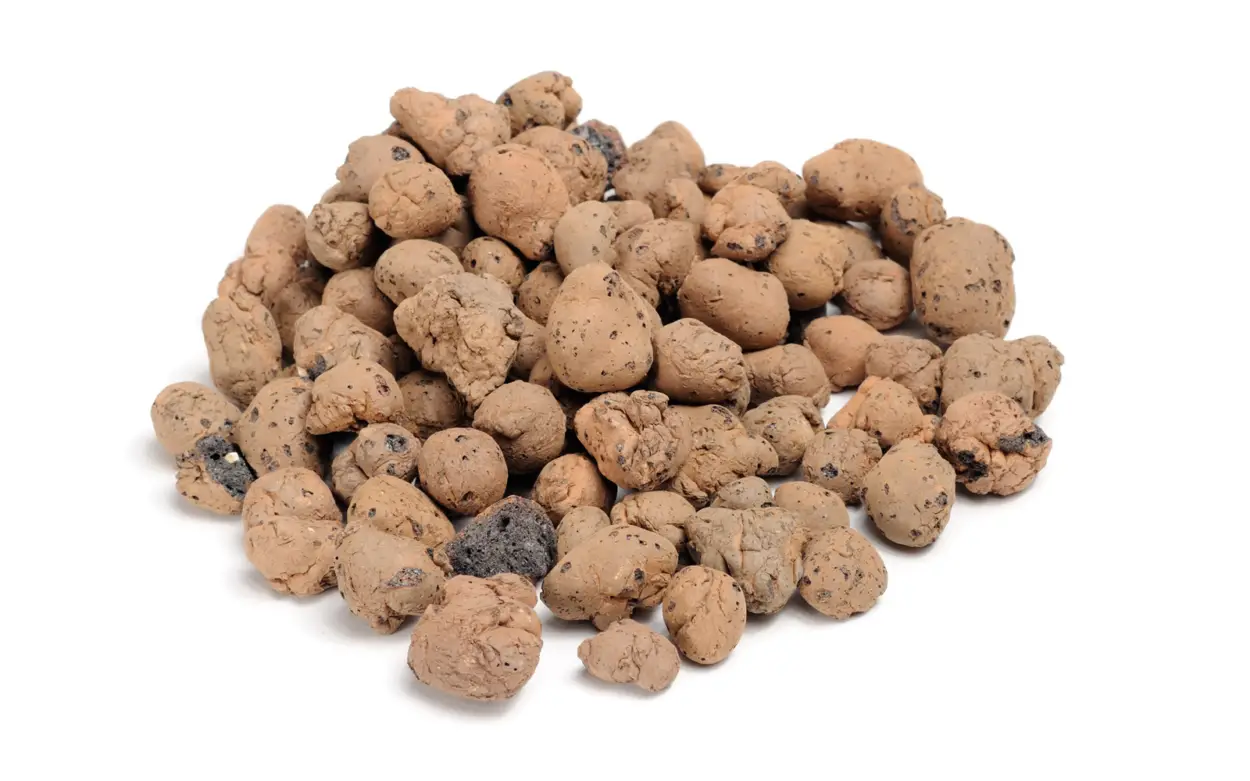
Sometimes called LECA or Hydroton, clay pebbles are a form of expanded clay that is milled into balls and baked at a very high temperature.
Clay has a few things over sponges. I love its versatility. You can grow just about any crop in clay pebbles, from the tiniest seedling up to the heartiest bush or shrub. It’s also reusable and can be washed and sterilized between crops. It has better electrical conductivity than most sponges and provides consistent aeration.
On the downside, clay pebbles don’t hold water as well as sponges. They’re far more expensive to purchase initially, especially for larger DIY systems, and many smaller commercial rigs don’t really work with pebbles at all.
Grow Sponge VS Rockwool
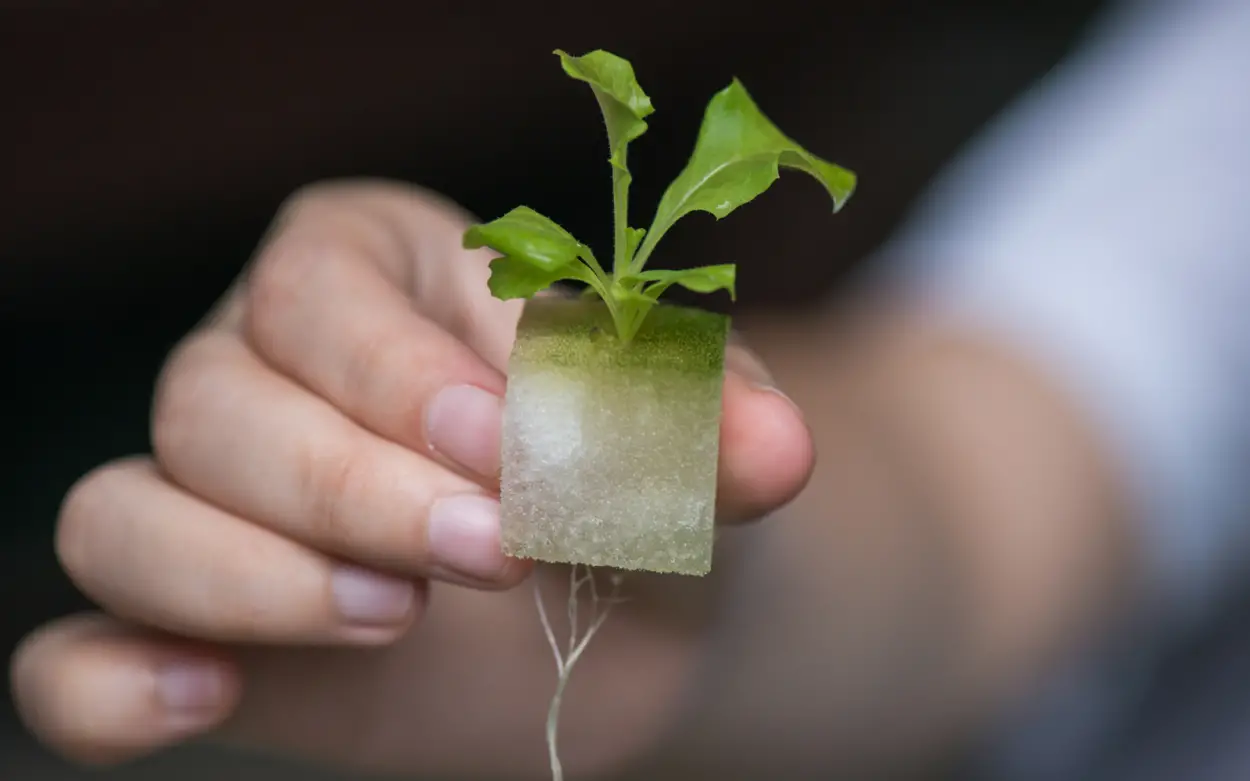
Rockwool, also known as mineral wool, is a form of a dense mat made from spun mineral fibers. It has spectacular water-holding properties and electrical conductivity, making it a popular choice for industrial growers. It’s also available in slabs, plugs, or precut into just about any size and shape you can imagine.
I’m personally not a big fan of rockwool. It can be temperamental out of the bag, and unlike sponges may well need to be treated to correct its pH. It’s also hazardous to cut when dry, as the fine fibers become airborne and can cause respiratory irritation when inhaled. It’s also very difficult to reuse, and while the same can be said for sponges all rockwool is inert and does not decompose. It must be sent to landfill once its job is done.
FAQ
Can I Just use a Kitchen Sponge in My Hydroponics?
Yes! Kitchen sponge is no different than commercial sponge, provided you check for a few factors before you use it.
Check the material first, and then inspect it to ensure it has good pore sizes and will drain appropriately for your crop. You’ll also need to clean and sterilize even new kitchen sponges before you start preparing them for your rig.
I sometimes use a kitchen sponge in my Aerogarden and can walk you through how to make your own AeroGarden pods.
What is a Good Substitute for Grow Sponges?
There are many alternatives for sponges when building your own homemade hydroponic garden. A lot comes down to what sort of system and what kind of plants you want to grow, but really choosing a medium is half the fun of building your own setup. I have a complete guide to the best hydroponic growing medium here for those who want to explore their options.
On the other hand, you need to be cautious when refilling a commercial hydroponics system. They tend to be calibrated for their own proprietary substrate, so it can be tricky working out an effective homemade alternative.
Final thoughts
I’m a relentless tinkerer and enjoy the challenge of shaping my own grow sponges. It’s very rewarding to see a tiny seedling turn into a thriving plant, all the while knowing the roots are held safe in something I crafted with my own hands. It makes the harvest all the more delicious.

Before you go!
The Kratky method: A Passive Hydroponic way to grow plants
7 Best AeroGarden Flowers to Grow
How To Grow AeroGarden Peppers
AeroGarden Lettuce: Complete buyers guide for your indoor garden